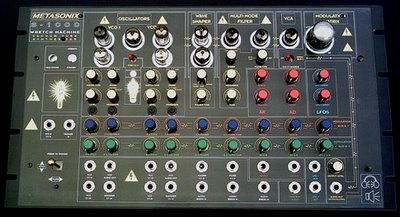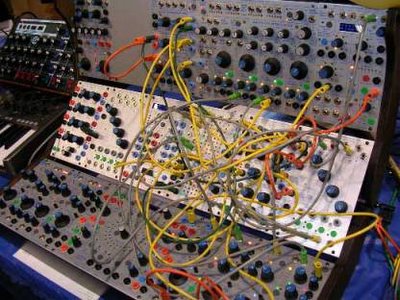Metasonix S1000 "Wretch Machine" prototype. Damn, that is one sexy looking behemoth of a synth (never thought I'd ever say that). Look at that thing! It's got tubes poppin out of it. Be careful... Title link takes you to a bigger shot and a PDF with details (I copied and pasted the details below in case you don't have a reader). Via Michael Weeks of
www.endmusik.com, via the floor of the
VTV expo. Thanks Michael!

Specs via the PDF in case you don't have a reader:
"The Ultimate Tube Synthesizer.
Pitch sources: two independent VCOs.
Made entirely of vacuum and gas-filled tubes.
Range >2 octaves using CV, octave switching allows range from
33 Hz (low C) to more than 2 kHz.
Three waveforms: thyratron sawtooth, square, and square with
suboctave.
VCO 2 may free-run or be soft-synced to VCO 1.
Numerous patch points allow enormous flexibility.
Waveshaper: unique circuit, with soft clipper and pulse adder
(shapes waveforms from VCOs by adding small pulses to top of
waveform at discontinuity).
Made entirely of vacuum tubes.
Settings: disable, soft-clip only, and soft-clip with pulses added to
signal. Latter circuit allows simulation of noise source.
Filter: unique multimode circuit, allows its use as a lowpass,
treble/midrange bandpass or bass bandpass filter.
Continuously variable control allows mixing of filter forms in any
proportion.
Made entirely of vacuum tubes.
Range of treble resonance switchable, 400-1700 Hz.
Bass resonance tunes from ~100-350 Hz.
Filter sweep is performed with photoresistor element.
VCA: unique circuit using a pentode tube.
Made entirely of a vacuum tube.
May be modulated with the AR generator only, or with the control
voltage generated on modulation bus 2.
Modulation: two envelope generators, A(S)R and AD.
Both triggered with input gate signal. Both may be combined on
either modulation bus to create ADSR.
Two independent LFOs, triangle waveform, range <0.3 Hz to more
than 5 Hz.
Two modulation buses allow combining the A(S)R, AD, and two
LFOs as needed to effect any CV input in the audio circuit (VCO
pitch, VCO squarer waveshape, waveshaper pulser, filter tuning).
Main CV input controls pitch of both VCOs (Hz/V response).
Gate input triggers envelope generators, accepts 0-5v or 0-10v
gate voltage.
6AL7 "eye" tube displays status of LFOs and A(S)R control voltages
on three separate glowing green bar graphs.
Miniature joystick performs multiple jobs: vertical motion affects
pitch of both VCOs, horizontal motion affects tuning of filter.
Press joystick in to trigger envelopes.
Size: 6U high standard EIA rack mount, 3" depth below rack panel.
11 vacuum/gas tubes. Weight about 20 pounds with AC adapter.
Draws 12 volts AC ONLY at 3 amps.
Expected availability mid-2006, expected retail price $2500.
Optional internal MIDI-CV interface, add $300."




















